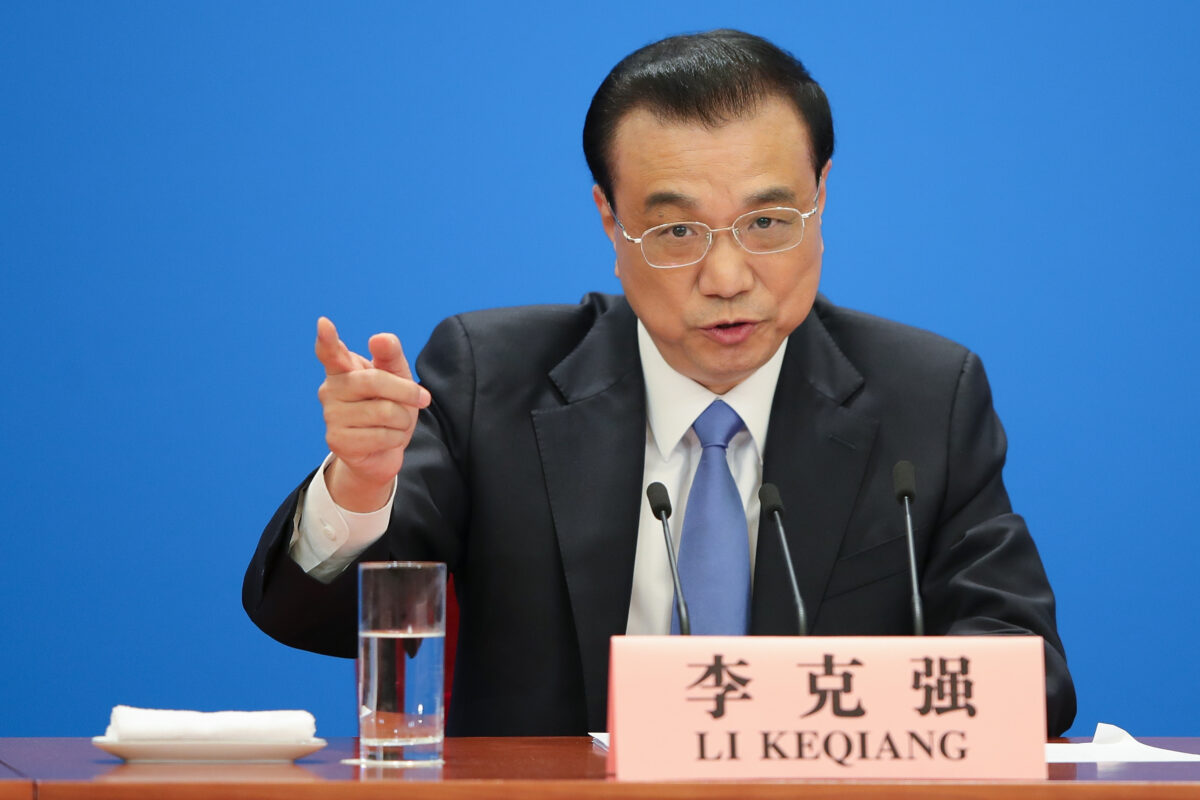US-China Economic Gap Widens; China Misses Turning Point in Prosperity
Distressed Patriotic Flag Unisex T-Shirt - Celebrate Comfort and Country $11.29 USD Get it here>>

China revised its GDP growth expectation for 2023; its GDP was only about 77 percent of the US GDP in 2021
News Analysis
China’s economy is growing stagnant, with the GDP growth prediction for 2023 officially assessed as the lowest in 30 years, indicating a total economic decline after the COVID-19 outbreak. Such a slump means a widening gap with the United States and a reversal of previous projections by economists that the Chinese economy would be on par with the United States by 2025 or 2030.
On March 5, Chinese Premier Li Keqiang delivered his tenure’s final government work report, which anticipated GDP growth for 2023 to be around 5 percent, the lowest growth target in the past 30 years of the communist regime.
The official expectation for GDP growth has decreased yearly in the past five years. In 2019, the official GDP target was revised (pdf) to 6 and 6.5 percent compared with 6.5 percent in 2018, followed by 6 percent in 2021 and about 5.5 percent in 2022, then 5 percent in 2023.
In 2020, the Chinese Communist Party (CCP) even stalled publishing growth predictions and other economic data due to substantial impacts from the onset of the COVID-19 pandemic.
This is a real setback for the CCP compared to the upward period from 1996 to 2014. Although the officially released GDP growth prediction had its ups and downs, it continued a high growth momentum. For example, as high as 8 percent of targeted GDP growth during 1996–1998 slid to 7 percent during 1999–2004, then rose to 8 percent for seven years from 2005 to 2011, followed by a slight drop of 7.5 percent during 2012–2014.
Comparing the expected GDP growth with the so-called “actual” GDP growth that the Chinese government made public afterward, the overall trend of “actual GDP” has transitioned from exceeding expectations by about 1 to 2 percentage points to declining with lower expectations or even below expectations.
The two years that COVID-19 blanketed China, 2020 and 2021, showed the worst economic performance.
In 2010, the CCP claimed that the “actual” GDP growth soared by 10.3 percent. However, it fell to 6.1 percent in 2019, a plummet of about 41 percent in 10 years.
CCP Dreams of Overtaking the West
The CCP has longed to overtake the West since the Mao Zedong era when Mao launched the Great Leap Forward. This radical economic and political campaign caused millions of people to die from widespread famine.
By around 2030, China and the United States will be on par with each other regarding economic volume. By about 2060, China’s GDP per capita will catch up with that of the U.S., according to Liu Zunyi (Lawrence J. Lau), board member of the China-United States Exchange Foundation, in an October 2015 economy publication of the Institute of global economics and finance of the Chinese University of Hong Kong.
In 2021, the pandemic-hit global market instantly pushed up demand for low-cost Chinese manufacturing, driving China’s economic growth for most of the year. The CCP’s upper echelons took it as a chance to expand. According to a report by Chinese media Sina in January 2021, provincial officials proposed views like “Rising East and Falling West”— East points to China, and West refers to the U.S.-led western countries—saying that the world has entered a period of turbulent change due to the COVID epidemic never seen in one century and the Communist ruling regime’s rise would be a key trend.
But such a boom lasted only a short time. In the fourth quarter of 2021, China’s exports topped with severely depressed domestic demand, a sluggish real estate market, and rapidly falling economic growth.
Liu’s economic projection likely provided a theoretical basis for Xi Jinping’s pledges to the world. Xi, after five years, committed in 2020 that China’s carbon emissions will peak by 2030 and the carbon neutrality goal will be achieved by 2060.
Liu served as a member of the economic committee of the CCP’s rubber stamp conference and an honorary fellow of the state-ruled Chinese Academy of Social Sciences.
Weakening Labor Force

In his article (pdf) titled “The Source of Chinese Economic Growth,” Liu held that China’s economic growth had been driven mainly by the accumulation of physical capital and labor input, with an almost total labor surplus.
But in recent years, China’s labor force has generally seen a downturn, with data from the National Bureau of Statistics showing that the working-age population aged 16-59 was 87.556 million in 2022, accounting for 62 percent of the national population. This is 6.66 million less than the 882.22 million in 2021, according to Chinese media outlet Jiemian on Feb.3.
In 2011, China’s working-age population peaked at 940.72 million and has since begun to decline, decreasing to 937.27 million in 2012. In 2018, the working-age population fell below 900 million to 897.29 million for the first time. This downward trend continued in 2019, decreasing by another 890,000 compared to the previous year.
As of January 2023, China’s birth rate has plunged for six consecutive years, new births have halved, and the country’s population is in negative growth, as reported by Chinese financial media Yicai.
Overdraft Public Investments
In Liu’s view, investing in public facilities and consumption is one way to boost the Chinese economy. But this was challenged by Wu Jinglian, a member of the unofficial Chinese Economists 50 Forum, who published an article on Dec.7, 2015, on Sina, rebutting that relying on investment to drive the economy is equivalent to eating the following year’s food, that is, the future resources are used to cover the current deficit.
“If we rely on the input of resources to solve the problem but do not have so many resources, with resources being increasingly scarce, what is invested in? It is debentures and debts.”
Overdrafting future resources will increase the balance sheet leverage of the nation, government, enterprises, and residents. “This will affect the stability of the entire national economy and create the so-called systemic risk,” Wu said.
Wu believes pulling the Chinese economy up through investment is “basically ineffective.”
Zhang Jun, dean of the School of Economics at Fudan University, is a similar view holder to Wu. On July 21, 2022, Zhang asked on the official website of the Fudan Development Institute, “Do we still expect investment to drive GDP growth?”
According to Wu, China’s return on capital investment in infrastructure is meager. At the same time, the size of China’s debt and corporate leverage is very high. The mismatch of financial resources is severe, “under such circumstances, once public capital spending is raised significantly, the pull on GDP will be minimal, not to mention a more serious drag on future economic growth.” Wu said.
Wu’s and Zhang’s economic opinions were both ignored by the Chinese authorities.
Beijing pumped up infrastructure investment in 2022 by as much as 9.4 percent year-on-year, a significant increase of 9.0 percentage points from 2021, to boost economic growth.

Chinese premier Li Keqiang stressed in his March 5 government work report the need to expand investment by increasing the amount of local government special bonds in the infrastructure projects, including transportation, water conservancy, energy, and information.
Economic Growth Slowdown
Liu’s prediction that China will match the United States in economic volume around 2030 is based on the premise that “Chinese economic growth sustains 7 percent in the next few years, while the U.S. economy grows at around 3.5 percent.
However, the 2020 COVID outbreak reduced China’s GDP growth to 2.2 percent. Moreover, even without the impact of the pandemic, according to a report on March 11, 2021, of Qiushi, the CCP’s official media, the economic growth rate in 2020 was likely below 6 percent.
Unattainable ‘Chinese Century’
Liu is not the first to compare China to the United States and assert that China’s economy will surpass America’s.
Another economist, Oded Shenkar, a U.S. China expert, said in 2006 that in 20 years (around 2025) or less, China will be the world’s largest economy, turning on a prosperous “Chinese Century.”
The year 2025 is near, but it seems less and less possible that the “Chinese Century” will start as the gap between the U.S. and Chinese economies has been at a turning point since 2022.
Looking at historical GDP data released by the U.S. and China’s official data, the ratio of China’s GDP to U.S. GDP has steadily increased since 1990. In 1990, China’s GDP was only 6.05 percent of the U.S. GDP; it increased to 11.82 percent in 2000, 40.60 percent in 2010, and 77.10 percent in 2021, according to a NetEase report on May 1, 2022.
And in 2022, the ratio of Chinese GDP to U.S. GDP was 71.26 percent, down 5.84 percent from 2021, the first drop of more than 1 percent since 1990.
In 2021, China’s total GDP was about $17.7 trillion, lagging behind $5.3 trillion from the U.S. $23.0 trillion. In 2022, China’s GDP amounted to $18.15 trillion at the average annual exchange rate, while the U.S. GDP reached $25.47 trillion; the difference grew to $7.32 trillion.
GDP per capita may indicate a country’s economic situation better than total GDP.
In 2021, China’s official GDP per capita was about $12,600, while the U.S. GDP per capita was $69,800, about 5.5 times that of China.
The gap is widening, with 2022 seeing China’s official GDP per capita at $12,741, while the U.S. GDP per capita is $76,658, about six times that of China.
Views expressed in this article are the opinions of the author and do not necessarily reflect the views of The Epoch Times.




